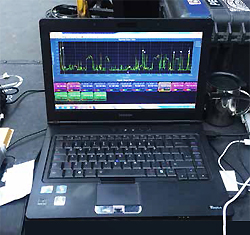In today’s ever-more-crowded RF environment, wireless system users need every advantage they can get to make sure their show comes off without a hit.
While wireless frequency coordination is not a new thing, I find that many in pro audio are unaware of it. This article will explain what it is and what it does, and take you through some scenarios to show how you can benefit from it.
Background
What’s the core issue? Wireless systems, specifically wireless transmitters, interact with each other. In much the same way that musical notes will combine to create overtones and undertones, wireless transmitters will combine to produce (and occupy) additional frequencies.
In its simplest form, wireless frequency coordination is a method for calculating these additional frequencies so that they may be avoided. While I won’t go into all of the math involved, the basic story is that two wireless transmitters will produce, below and above each frequency, new frequencies that are the same spacing as the two frequencies are apart. These new frequencies are called intermodulation (or intermod) products.
For example:
Frequency 1 = 501.000 MHz,
Frequency 2 = 502.000 MHz,
Spacing = 1.0 MHz
Therefore, the intermod products will occur at 500.000 MHz and 503.000 MHz, which means that if you’re looking for two more channels, you can’t use 500.000 MHz and 503.000 MHz. Just to make life more interesting, this same thing occurs between every existing frequency and every new one.
So if you bring on another system at, say, 505.000 MHz, say good-bye to: 497.000, 498.000, 499.000, 508.000 and 509.000 MHz. It adds up, and quickly. (You may have also gathered by now that it’s not a good idea to use even spacing when selecting more than two frequencies).
But these intermod products are only potential problems, because the transmitters have to be able to interact with each other to produce them. This usually means that they have to be in close proximity to each other. Does this get you off the hook? No.
Following are some scenarios of how this can bite you in real life, but for now, keep in mind that transmitters that are putting out a steady signal, like in-ear transmitters or intercom base stations, can interact with wireless mics, guitar packs, etc. that are in the same area.
Also understand that if signals are being combined, like in an IEM system, and there are intermod products from poorly selected frequencies, you’ll be broadcasting the intermod products as well as your in-ear mixes.
Scenario 1
You’re working with a rock band. Stage right and stage left both have guitar rigs, each with its own tech. Off stage left is monitor beach. The stage right guitar tech scans around and sets his guitar wireless system at 550.000 MHz. The stage left guitar tech does the same and finds a clear frequency at 555.000 MHz. The monitor tech scans, and then puts the singer’s IEM pack at 560.000 MHz and his vocal mic at 545.000 MHz.
Everything sounds clean, checks out fine at sound check, and works great for most of the show until the two guitar players, who haven’t been speaking to each other for most of the tour, suddenly decide to have a Spinal Tap moment and do that leaning on each other’s backs shtick…which puts their guitar transmitters (belt packs) in close proximity. Suddenly, the singer is tearing out his earbuds, shooting nasty looks at the monitor tech and trying to keep his pitch via the wedge mix (remember those?).
After the show there’s a whole bunch of speculation and shoulder shrugging about where this terrible interference came from, with everyone having their belief that wireless is inherently prone to this sort of thing firmly reinforced. But what can you do?
Each of the three techs choosing frequencies exercised due diligence and scanned for a clear frequencies, right? The real problem is that the frequencies were not properly coordinated, which allowed the guitar packs to create an intermod product that landed right on the singer’s IEM frequency, as well as the frequency of his wireless mic system.
This raises the question: How is frequency coordination different from scanning? Frequency coordination is predictive while scanning is reactive. Scanning can only show you what potential sources of interference are in a given area when you’re looking and when they’re happening. Coordination, on the other hand, predicts sources of interference and offer a selection of frequencies to avoid them.




















